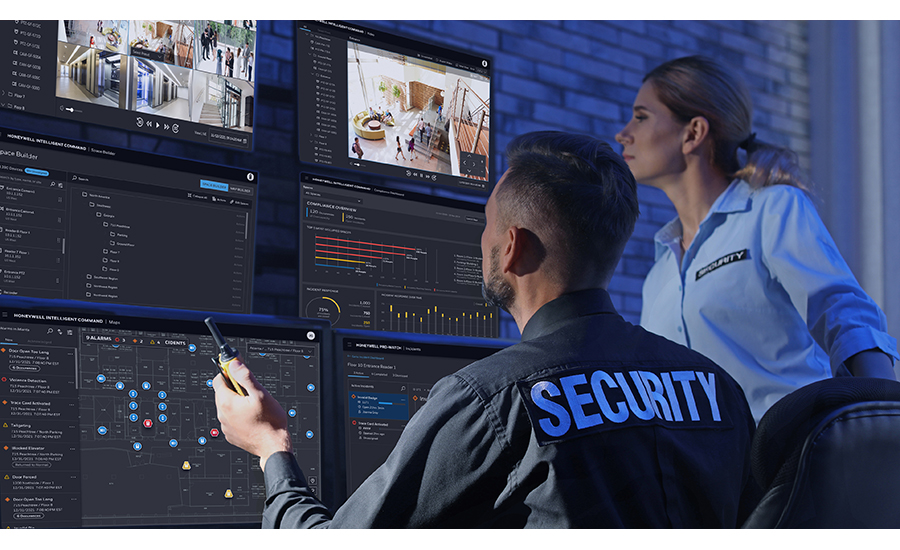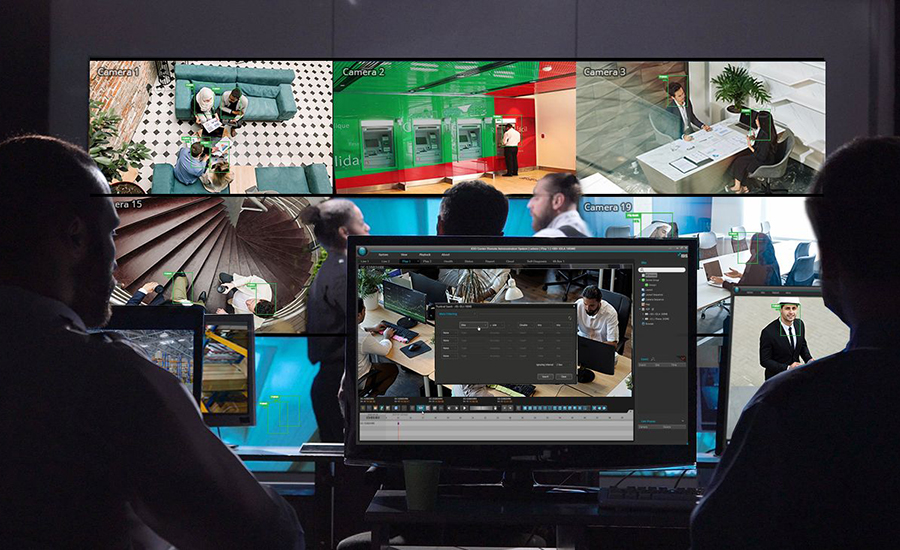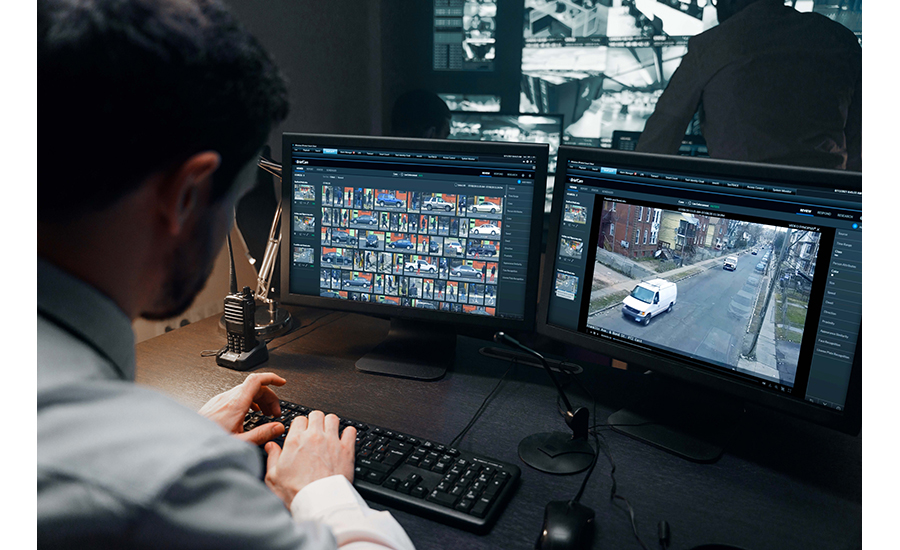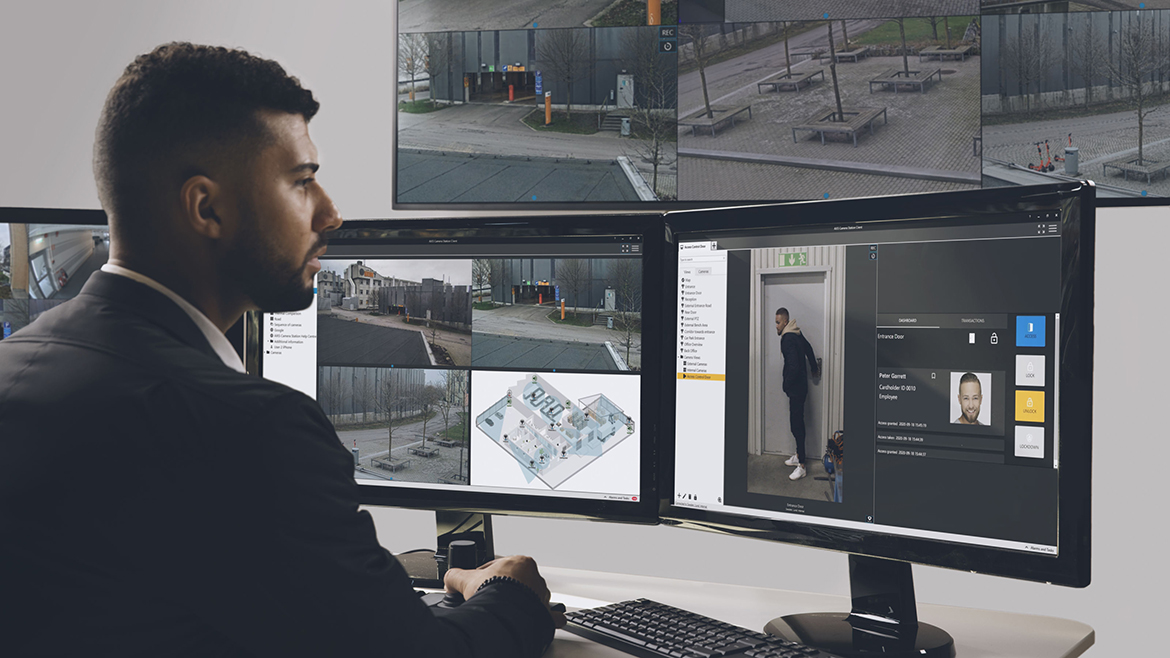Today there is a huge spike in new, third-party software and hardware technologies available for video management systems (VMS). This fact alone means that the VMS may be the most important component of your customer’s surveillance system. When selecting a VMS, security integrators should evaluate not only how it collects, records/stores and displays live and recorded video from cameras; they also should consider the vast array of additional tasks the VMS can do through third-party software and hardware.
There are hundreds of different applications available today — many of which are powered by artificial intelligence — that a VMS can administer. Among them are:
- Sophisticated video monitor walls.
- Powerful forensic searches.
- License plate recognition.
- Access control system management.
- Asset security and tracking.
- Monitoring restricted security areas.
- Monitoring acoustic/sound sensors.
- Vape and air-quality detection.
- Central station live video monitoring.
- Privacy masking.
- Point-of-sale integrations.
- Geolocation services.
- Smart building management.
- Facial detection.
- Radar and lidar sensors.
- Vehicle scales.
- Wide variety of analytics.

“If [integrators] can’t stay ahead and bridge the expanding gap between a customer’s current system and their future aspirations, they risk facing a rip-and-replace scenario.”
— Dave Nieweg, Milestone Systems
In order to be competitive in the security marketplace, it is essential that a VMS provides security integrators with access to third-party solutions. Access starts with manufacturers designing systems that allow integration to occur without difficulty. Beyond this, integrators can select manufacturers that have technical partnerships with a wide range of other software and hardware companies.
“That is precisely what a systems integrator is supposed to do — integrate various software and hardware systems to create a unified security system that addresses their customers’ unique situations, concerns and issues,” says Dan Berg, senior product manager for integrations at Salient Systems, Austin, Texas.
Access to third-party software and hardware has many benefits, including flexibility, innovation, interoperability, cost-effectiveness, scalability and future-proofing of the security system, says Jason Burrows, sales director at IDIS America, Coppell, Texas. “In turn, it offers more project upgrade opportunities,” he says.
Some VMS companies offer hundreds of third-party integrations. “That means there’s a lot of competition within even specific ones, such as biometrics, which gives you better pricing options so integrators can do more,” says William Hinton, product line manager at Genetec Security, Montreal. Having many options helps integrators address customers’ different size budgets and system sizes, as well as their changing requirements over time.
“I think it boils down to choice and options; no one wants to say ‘No’ to their customers,” Hinton says. “We want to be able to say, ‘Yes, I can do that.’ Having access to third-party integration software/hardware gives you more options to tailor to your customers’ needs.”
Even some highly unique problems can be solved with special sensors integrated with a VMS. For example, Genetec’s VMS pairs with sensors that perform heat and visual analytics to ensure with very high precision that the gas flares used to burn off chemicals in gas/petroleum refineries stay lit so that the refineries comply with laws that prohibit releasing noxious fumes into the atmosphere.
“Third-party solutions are beneficial for the integrator because they allow integrators to expand their total offerings, penetrate new markets, and meet different needs outside of their current scope through the adoption of new technology within a familiar VMS framework,” describes Vincent Campisano, program manager for video management at Axis Communications, Chelmsford, Mass.
Michael Brewer, North American regional marketing manager for recording and storage solutions at Bosch Security and Safety Systems, Fairport, N.Y., concurs, saying, “With rapidly evolving system requirements, no one manufacturer can provide everything that every customer might need. It is important that integrators consider VMS solutions that are flexible with providers willing to integrate with the new third-party solutions becoming available.”
An often-overlooked aspect of open architecture software is the fact that multiple third-party companies produce similar products. This provides a layer of redundancy, because there is often a similar solution that can be easily implemented as a backup plan, Campisano says. “Open architecture systems help keep integrators on their A-game with constantly evolving offerings.”

Restrictions of Closed Architecture
Dave Nieweg, community program manager at Milestone Systems, Portland, Ore., says that an integrator’s ability to swiftly adapt to emerging technologies and trends can be the difference between retaining or losing clients. “If they can’t stay ahead and bridge the expanding gap between a customer’s current system and their future aspirations, they risk facing a rip-and-replace scenario.”
In this regard, security integrators need to rely on manufacturers to be open to third-party technology partnerships. However, Nieweg, like others, believes that many video management systems generally are not keeping pace and that the security industry is lagging behind in leveraging the rapid advancements seen in other sectors. This is due to many security systems having closed architecture, where it takes a lot of work by the owning company to build rich features and functions into their platform to leverage the new technologies, he says.
In contrast, open platform VMS enable a rich ecosystem of third-party software and hardware to flourish, Nieweg says. “In today’s fast-evolving world, it’s critical for systems to possess the agility to incorporate new features swiftly and phase them out when obsolete,” he emphasizes.
“Third-party solutions are beneficial for the integrator because they allow integrators to expand their total offerings, penetrate new markets, and meet different needs outside of their current scope through the adoption of new technology within a familiar VMS framework.”
— Vincent Campisano, Axis Communications
Hinton points out that it’s not necessarily realistic for a closed VMS to keep pace with all of the innovation in third-party software and hardware occurring today. “Simply look at your iPhone — could your iPhone possibly live without the App Store? Think of all the different value that gets added to that,” he says.
Part of the discussion about open architecture is philosophical; manufacturers such as Genetec and others want to offer as many choices as possible — in cameras, storage and more — to their customers. “But it’s also technical in that you have to have compatibility with the protocols that are used in order to communicate with our software solution,” Hinton describes. “Being open to these standard protocols for communication is part of that open architecture.”
One of the parts of open architecture is linked to the Open Network Video Interface Forum (ONVIF), an open industry forum that provides for standardized interoperability of IP-based security products. Many VMS platforms have compatibility to one or more of the ONVIF profiles. While ONVIF prescribes certain levels of compatibility, some manufacturers go beyond that to offer deeper functionality based on their open integration partnerships.

How Integrations Are Handled
Integrations between open VMS manufacturers and third-party software and hardware can be accomplished several different ways, including through software development kits (SDKs) and application programming interfaces (APIs).
“SDK is a development package that contains a set of code libraries, samples and documentation that enables developers to create custom solutions and integrations with Genetec Security Center (GSC), our flagship product,” Hinton says. “In addition to this main GSC SDK, we have other GSC features/modules, as well as other Genetec products … that have their own APIs that enable communication and integration via a set of API calls/commands. These are all documented and available for internal or public use.”
As further examples, the latest version of the Bosch Video Management System features a new REST API that provides easy integration development for emerging third-party solutions, Brewer describes.
Honeywell’s partners can make use of integration APIs in its MAXPRO VMS open-technology solution to leverage events and attributes from many third-party systems in a seamless manner on MAXPRO interface. “Open technology and standards are always a key to future-proofing of technology platforms like VMS, as third-party products become available in the marketplace,” says Tami Wenzel, senior offering manager, commercial security, at Honeywell Building Technologies, Atlanta.
And Salient’s CompleteView VMS is an open platform, meaning it runs on non-proprietary hardware, offers multiple APIs for integration with third-party systems, and supports industry standards such as ONVIF which provide effective means to ensure interoperability with virtually any camera, Berg notes.
In addition to server-based systems, cloud VMS architectures also can be open to third-party integrations. One example is the Eagle Eye Networks Cloud VMS platform, which uses an API ecosystem that the company says attracts considerable third-party innovations and provides for cybersecurity of the data.

“What’s unique about a cloud-based VMS is that we build our software on top of our own APIs. So, all of those tech partnership integrations — third-party software or hardware functionality — are really predicated on some other company using our APIs to either pull video out of our system or use some of the features in our system inside of their user interface,” describes Ken Francis, president of Austin, Texas-based Eagle Eye Networks. “That’s what truly defines an API ecosystem. We have hundreds and hundreds of tech partners who use our documented API, which we’ve been publishing since the inception of the company.”
Eagle Eye says it is this API economy that enables third-party software and hardware to function well with VMS and to keep pace with today’s level of integration.
Campisano at Axis Communications says when it comes to VMS developers and security manufacturers keeping pace with newer technology, including AI or edge devices, it almost always boils down to their go-to-market strategy. “It is far simpler, both logistically and developmentally, to integrate new third-party hardware or software into an open architecture VMS. This provides an integrator with the added benefit of being able to solve unique or complex customer problems in an agile way,” Campisano says.

“Open-architecture hardware also plays a significant role in directly integrating into a VMS. This provides two avenues of third-party software integration: first at the VMS level, and second at the physical hardware level,” he explains. “Open-source cameras can use third-party applications, which may be developed to run at the edge and integrate into a VMS — as opposed to directly integrating with the software.
“VMS providers utilizing closed architecture will have a more difficult time justifying and implementing third-party technologies due to the proprietary nature of their product. The inverse of this is true for open-architecture systems. Open software allows for customized adjustments and integration of new technology, but the complexity of a solution will increase directly with a software’s ability to meet specific and niche applications,” Campisano believes.
Overall, open-architecture solutions will keep up with the innovation of third-party technology much more effectively than closed solutions, he adds. And that plays a big role in a VMS’s ability to nimbly adapt to market shifts with cutting-edge technology.




